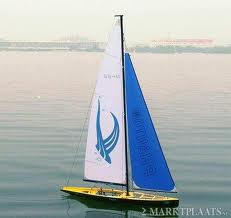Phantom Specifications and
Modifications
Click for sail
numbers already issued for phantoms

Please note these
are current ideas for defining variations within the
Phantom yacht
There appears to be no detailed specifications that define the
Phantom RC sailing yacht. From discussions with our group
t a standard set of guidelines about what can and can't be
modified on the yacht have been determined.
-
The hull should remain essentially as
supplied by the manufacturer and re-moulding the hull in
glass or carbon fibre etc would
be not acceptable.
-
The fin
and rudder should remain as supplied by the
manufacturer though if broken may be remade in timber,
glass, carbon etc to the same dimensions and shape, matching
the airfoil as closely as possible. Replacing the
rudder with a larger one is highly desirable for control and
balance of the yacht and should be considered as an allowed
option. The rudder may be repositioned further aft vastly
improving control
-
The ballast container may be
replaced by a lead bulb whose max weight is ~2000g and whose
vertical dimension is no greater than the original bulb.
(Almost impossible to get 2000g in original bulb but is
essential to get performance. The bulb needs to be
moved aft to prevent nose-diving as weight increases.
-
The mast should remain as supplied by the
manufacturer. If broken this raises a problem of
resupplying a mast of the same section. It may be
necessary to allow some replacement in the future but for
now
breaks can be repaired using a joiner similar to that
supplied by the manufacturer.
-
Booms may be replaced if broken though
the main boom is quite strong. If replaced then the
boom lengths should not exceed those supplied by the
manufacturer.
-
Booms and vang may be modified to allow
the vang to be adjustable and the boom to pivot at the
gooseneck as it improves the setting of the sails and makes
their adjustment much easier for skippers.
-
The main sheet winch may be replaced by
the same or similar model as they are available through model suppliers.
-
The steering servo may be replaced with
standard servos available at model shops.
The sails form a special case as those
supplied by the manufacturer vary so much in quality and
efficiency that modifications are a necessity in most
situations. There are however statements made by the manufacture
about the sail area being 0.4 m2. From
calculations from a number of yachts this is the triangular area
of the main and jib. The triangular area is defined as the
luff multiplied by the foot perpendicular (minimum distance from
the clew to the luff) divided by 2. Any modifications to
the existing sail must not enlarge the existing sail but should
allow for reshaping of the luff. Seams
can be used
for additional shaping and battens may be used to assist setting
of the sail. Both the mainsail and the jib have a
significant amount of roach whose area is not measured in the
0.4m2. Sails may be replaced but must conform
to the maximum area above, made of a single piece of material
and must fall within a standard set of
dimensions.
Sails can be produced or purchased meeting the following
max dimensions and can now be shaped with
seams if desired. Cut-down Mylar IOM sails
is one way to go and perform well
Mainsail - Luff: 1255mm, Foot perpendicular: 350mm, 3/4
point:163mm, 1/2 point: 250mm, 1/4 point: 313mm
Jib - Luff: 1140mm, Foot perpendicular: 315mm, 3/4 point:
99mm, 1/2 point: 178mm, 1/4 point: 246mm.
The 1/4, 1/2 and 3/4 points define the max
roach at those points. The roach may be drawn in a smooth
curve to pass through these points. These dimensions
define the area of the sail as 0.3992m2 which lies
within the dimensions of the supplied sail.
If in doubt about these dimensions then the sail outline must
fall within those of the original sail. NB this means that smaller sails may be made and used providing
they meet these criteria.
NB sails MUST carry clearly visible numbers to identify the
yacht. See
Sail Identification document for size and position of
numbers. Sail numbers need a contrasting colour to be
visible particularly on the dark blue jib. Considering
this difficulty, numbers only on the mainsail will be accepted.
-
Fittings attached to the mast, booms and
deck may be modified to improve their strength, assist in
the setting of the sails or sheets.
-
Shrouds may be replaced by better quality
cord or wire.
-
Deck modifications to reduce the ingress
of water through the hatch area are acceptable.
-
The steering mechanism including the
servo, rudder posts, rudder steering arm etc may be modified
to improve the handling of the vessel.
-
Sheeting guides to direct the main and
jib sheets are acceptable.
In general, other modifications are
acceptable if they do not essentially change the yacht or its
dimensions but
improve its handling and seaworthiness.
page
last edited on
04/05/2025